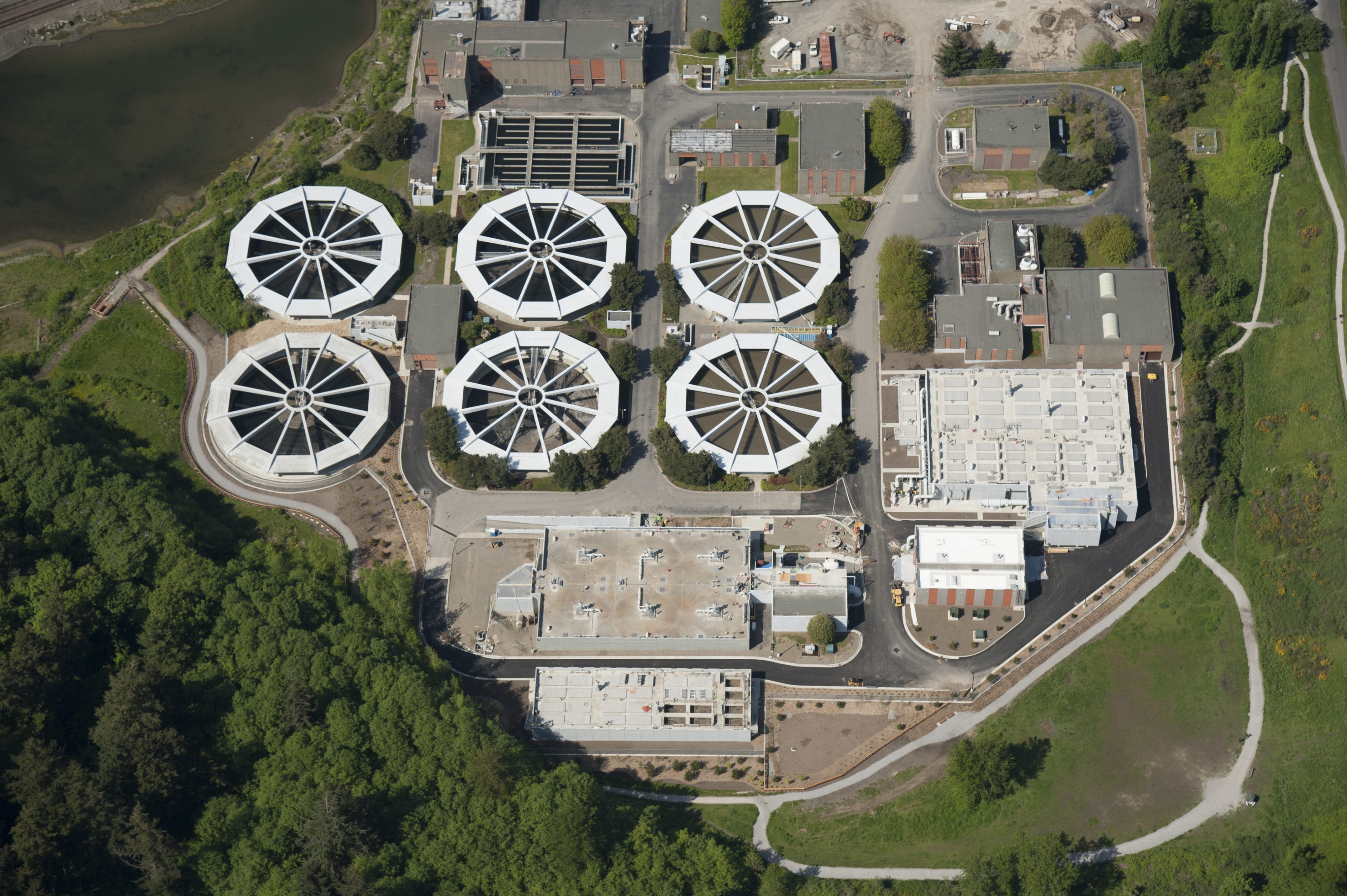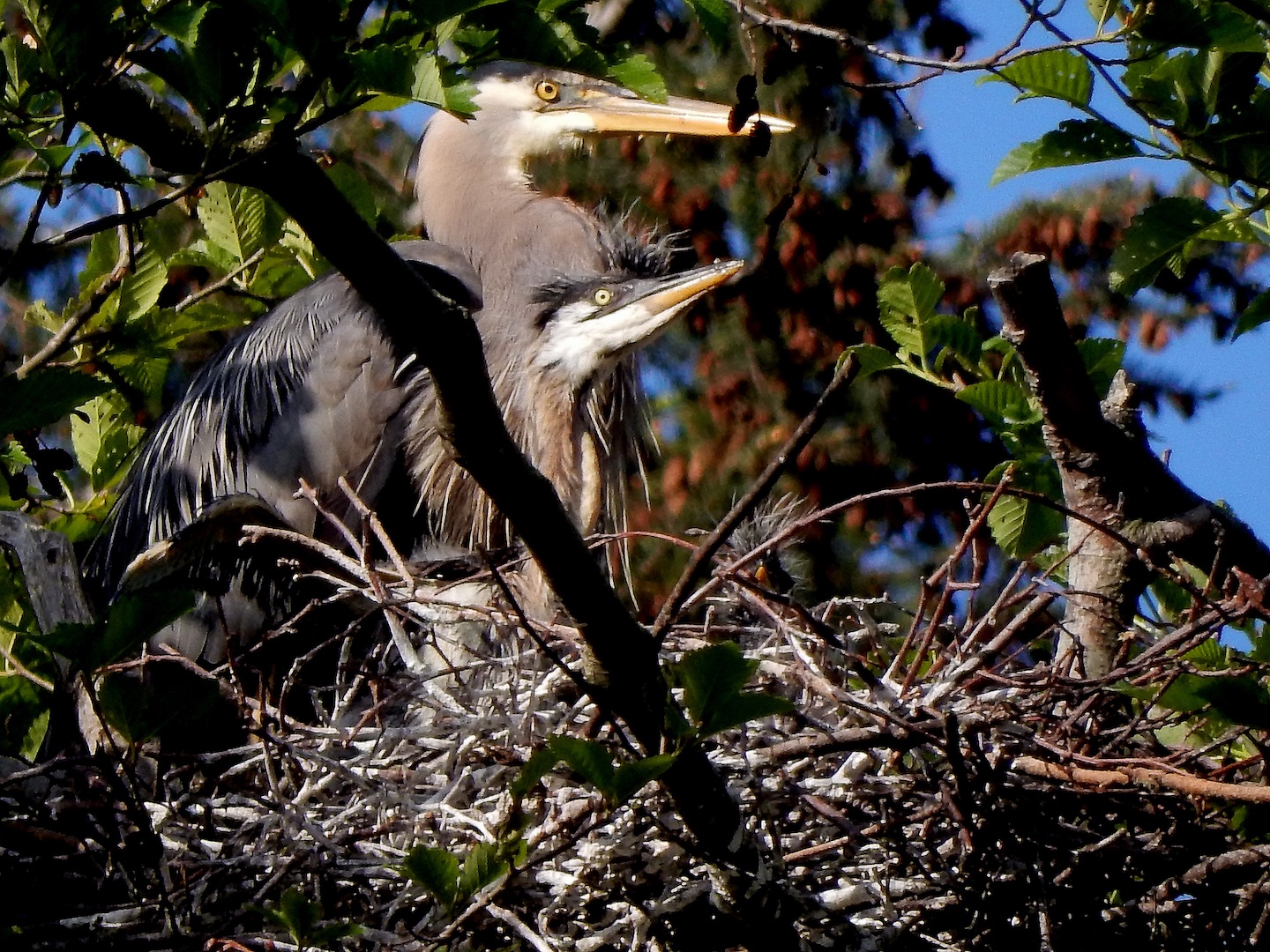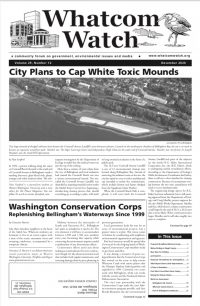by David M. Schmalz
Since January 2014, Whatcom Watch has been rerunning articles from issues printed 20 years ago. The below article appeared in the December 2000 issue of Whatcom Watch.
Editor’s Note: The purchase of the property by the city of Bellingham to protect the herons is still pending. For the latest on foot dragging by the city, see articles by Jamie K. Donaldson at Northwest Citizen.
https://nwcitizen.com/writer/3206/Jamie%20K.%20Donaldson
The great blue heron turned in her glide, drew in her extended neck, and briefly stalled. Approaching the treetop, she fully extended her wings and fluttered them like a cloak, landing rather inelegantly atop a disheveled pile of branches and twigs. The nest tree. Around this nest tree, there were others. Not many, but a few.
Thus, a potentially high profile wildlife conservation issue has landed on the slopes of Edgemoor in south Bellingham. Within the canopy of the forested belt above the Post Point Sewerage Treatment facility, a small colony of great blue herons has established a nesting site immediately adjacent to property slated for intensive residential development.
In an urban environment, the needs of wildlife and the actions of humans are often in conflict. In this instance, there are the herons, which have newly settled in one of a rapidly dwindling number of locations suitable to their needs for nesting and rearing their young. And then there are citizens, who wish to develop their adjacent land in accordance with the zoning requirements and development standards for the site established by the city.
How these two interests balance and more importantly how successfully they are balanced from the point of view of the herons, will be due, in large part, to the temperament and actions of the developer/property owner, the regulatory authority of the city of Bellingham and the involvement of the greater citizenry of our community.
Much of habitat degradation in an urban setting happens incrementally and involves less charismatic creatures than the great blue heron. Even in the case of such a majestic and emblematic bird as “great blue,” the fact is, there are precious few “must do’s” with regard to the protective measures that are required by law for this species.
Thus, the Post Point herons clearly shine a light on the question of how successfully our community can balance the needs and desires of people with the needs of wildlife. Moreover, the Post Point heron colony, will, for better or worse, provide a strong indication of the value this community places on wildlife and habitat.
Wildlife Needs/Human Desires
The city is currently reviewing a development application for what is being called “The Point at Shorewood,” submitted by Triple R Construction. The subject property is approximately 1.6 acres, located above the toe of the ridge which rises just to the south of the Post Point Sewerage Treatment plant. Triple R proposes to divide the property into eight cluster attached lots with an approximately one-half acre open space tract. Current zoning on the property allows for this configuration, having been changed from single family residential in 1988. The subdivision will place eight lots on the site, that under current zoning for surrounding property would only allow three.
The Post Point nest trees are located on city-owned land directly abutting and below the development site. The city parcel is wooded and steeply sloped toward Bellingham Bay. The portion of the canopy in which the nests are located is near the bluff line, basically at eye-level to the Triple R site.
Nesting Sites
The availability and quality of nesting sites is critically important to local bird conservation. Great blue herons, in particular, are sensitive to noise and disruption, and heron nesting sites are fairly readily abandoned when there are inadequate protective buffers.
In fact, it is entirely likely that some, if not most, of the members of the Post Point colony only began utilizing this site after they were displaced by development pressure from their previous nesting trees near Chuckanut Village. In spring of 1999, clearing for, and initial construction of what was introduced as “Heron Estates” was most likely what caused a five to seven nest colony to be abruptly abandoned there. Construction of one home occurred almost directly beneath a nest tree.
As luck would have it, there was still someplace else for these birds to go. This time. Heron fans were heartened when apparently some, if not all, of the individuals from the Chuckanut Village colony relocated at Post Point. A possible attractant at the Post Point site was an existing single nesting tree, which has been used successfully for the past four consecutive years. Also, the new colony site lies within the same upland forest, bay/cove/lagoon habitat as the former colony in Chuckanut Village — a favorable habitat for nesting and rearing of young. Additionally, the slope and canopy characteristics at Post Point provide some protection from predacious bald eagles.
Feathered Pioneers or Remnant Holdouts?
The Post Point colony is estimated to have between five and nine nests. This small colony raises some interesting questions with regard to its biological status and significance. Are these herons representative of the last of urban breeders in Bellingham, slowly being squeezed out by development pressure and loss of habitat? Or are they representative of what are called, pioneers — or rogues — whose function is to spread out and explore new habitat, dispersing the gene pool from larger more intensive breeding colonies?
While some things are uncertain about this particular colony, other facts remain crystal clear. This is the only remaining great blue heron nesting colony in the city. Moreover, great blue herons, especially nesting colonies and rearing sites, are under tremendous development pressure, particularly when viewed from a regional habitat perspective.
The Regulatory Dilemma
Unfortunately, splendid as they are, great blue herons are not afforded the same sort of protection that applies to endangered species. Although classified as a Priority Species of Concern by Washington state, federal and state regulations are often not enough, in an instance like this, to prevent an individual nest, or even a small colony, from being displaced.
However, the city of Bellingham also has the power to require protection of wildlife habitat and individual species within city limits. In fact, the city, as a jurisdiction, has the authority to seek and require greater site-specific protection measures than federal or state statutes often provide for.
The city is still actively gathering information about the Post Point colony. The Bellingham Department of Planning and Community Development is in the process of drafting a preliminary plat resolution for The Point at Shorewood, which will establish conditions for numerous aspects of the development. It is within this resolution that specific language for heron protection will be spelled out and then administered through one or more of the permits required for the developer to move forward.
According to Chris Spens, senior planner with the city of Bellingham, the city is still exploring options for measures that would protect the herons. Ongoing information gathering includes the mapping of nest trees and the development of a site requirement analysis based on the needs of the herons.
Recognizing that much of Bellingham’s earlier development was often insensitive to the needs of wildlife and protection of wildlife habitat, the planning department now strives to operate under a policy that “leaves room for wildlife.” With this interest in mind, planners are looking at a range of protective strategies that establish varying degrees of assurance that the herons will continue to use the nesting site throughout the development and occupancy of The Point at Shorewood.

The Post Point plant in South Bellingham. The blue heron rookery is located in the trees at the bottom left. Photo: courtesy City of Bellingham
Public Land at Post Point
The public property at Post Point is a mix of managed landscape and open space, including the long band of forested bluff which slopes down from Edgemoor above. A portion of this publicly owned bluff is subject to “windowing” (selective tree cutting and thinning) as provided for through an agreement between bluff-top property owners and the city.
The long-term vegetation management plan for the forested belt includes rotating out deciduous trees and planting of conifers. It has been the city’s intent to maintain significant acreage in a linear belt that will, among other functions, provide wildlife habitat. Now that the herons have arrived, hopefully, their needs will be considered in the actual timing and implementation of this plan.
Among other variables the city is considering is the availability of alternative habitat for the colony, preferably nearby. Clark’s Point, Chuckanut Ridge, and some smaller forested parcels in the vicinity have been identified. The fact that there is a wide range of tolerance among heron colonies, and even among individual birds themselves, further complicates the determination of what level of protection to provide. There is also strong motivation for the city to develop a protective strategy that will engage the cooperation of the landowner/developer, and failing cooperation, can at the very least, withstand legal challenges.
Community Response
Whatever protective strategy for the herons the city comes up with will likely be universally acknowledged as a gamble — something of a crapshoot. A starting point for protection was recently established by the City of Bellingham Hearing Examiner. The hearing examiner is charged with reviewing development applications in terms of their relationship to the city’s zoning laws, building codes, development standards, and comprehensive plan goals and policies.
In her November 8, 2000, decision, hearing examiner Dawn Sturwold approved the preliminary plat proposal under the condition that “ No clearing or construction may occur within 200 feet of any heron nest between March 1 and July 31.” Although this condition only shields the colony from clearing and construction impacts during the breeding season, Sturwold also noted in another condition that:
“At or prior to the time of final plat approval, the City Council may want to review the Post Point Vegetation Management Plan in light of the recent establishment of the heron colony and the assessment and recommendations of Ann Eissinger. The assessment and other portions of the record for this plat that relate to that plan and the heron colony should be provided to council.”
City Council Should Review Plan
Sturwold’s ruling clearly forwards responsibility for further deliberations on the issue of heron colony protection to the full City Council. And, it is before the City Council that community concerns can most effectively be raised regarding this issue. There are numerous uncertainties related to the likelihood of insuring the success of this breeding colony at the Post Point site. Many are such that, once a protective strategy is developed, codified and implemented, we must all simply wait and see what happens.
However, there remain important aspects of this issue where community involvement stands to play a significant role in determining what level of protection will be afforded the Post Point colony. The North Cascades Audubon Society and a handful of concerned residents have submitted comments to the city on this matter. However, if this particular heron colony and wildlife habitat in general is important to our community, now is the time to inform the city of your views regarding this important wildlife conservation issue.
There is still time, while the planning department is developing protective measures, to add your voice to those who highly value this colony and what it represents for wildlife and our community. A strong public statement will not only likely influence the level of protection afforded this colony; it will greatly strengthen the city’s ultimate position and requirements with broad, citizen support.
Following are some outstanding issues and questions which still require further consideration:
1. Buffers: What size buffers are necessary to protect the colony aside from those established for clearing and construction? How close will structures be allowed to nest trees? What buffers will be provided to shield herons from activities of residents once units are occupied?
2. Monitoring: What system of monitoring impacts to the colony will be put in place? Will it include monitoring of pre-, during and post construction and occupancy? What party will be responsible for such monitoring, and what additional provisions will be provided to increase mitigation in the event of unacceptable disturbance to the colony?
3. Risk: Given the fact that this nesting colony is quite likely comprised of individuals displaced from the Chuckanut Village site, what is different about the protective measures for The Point at Shorewood that will insure a greater chance of success?
4. Philosophical/Ethical: Although slightly less specific, these questions are extremely important for us to ask ourselves as a community, and how they are answered will affect far more than just this colony of herons.
What is the value of this colony to the community? What level of responsibility does the community accept for protection of this colony and critical wildlife habitat in general? Where is wildlife in the minds of the citizens of Bellingham? How well are we, as a community, making the link between healthy wildlife populations, highly functioning natural systems, a healthy environment and a higher quality of life?
Please consider commenting on this important issue, whether to make specific recommendations or to express general support for wildlife and wildlife habitat in our community. The level of public participation in this issue will influence what level of protection this colony will ultimately be provided. Moreover, a strong community response to this issue will likely influence future decisions made about wildlife and habitat protection in our community.
________________________________
When this article was written David M. Schmalz was vice president and conservation chair of the North Cascades Audubon Society.






























